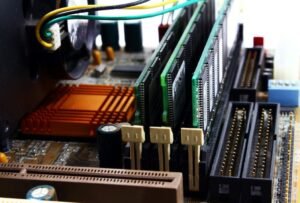Artificial Intelligence U.S. Government
Artificial intelligence (AI) has become a prominent topic across various sectors, and the U.S. government has recognized its potential impact on the country’s economy, national security, and public services. The government’s pursuit of AI research, development, and implementation is aimed at harnessing the benefits of this technology while addressing potential challenges and risks.
Key Takeaways:
- The U.S. government is actively engaged in AI research, development, and implementation.
- AI has the potential to revolutionize numerous sectors and improve public services.
- The government is focused on addressing ethical considerations and potential risks associated with AI.
- Collaboration between the government, private sector, and academia is crucial for AI advancement.
Government Initiatives
The U.S. government has launched several initiatives to promote AI research and development. In 2018, the White House released the National AI Research and Development Strategic Plan, which emphasizes the importance of AI in sustaining economic growth, enhancing national security, and improving quality of life. This plan outlines key strategies for federal agencies to accelerate AI advancements, including investments in research, development, and the workforce. *The government aims to harness the transformative potential of AI to benefit American society and maintain U.S. leadership in this domain.
Public-Private Partnerships
Recognizing the need for collaboration, the U.S. government has engaged in partnerships with the private sector and academia to leverage their expertise and resources. *These collaborations foster innovation and accelerate AI development by pooling knowledge and capabilities. Through initiatives such as the National AI Initiative Act, the government encourages partnerships to promote AI research, education, and workforce development. By combining the strengths of various stakeholders, the government aims to drive AI advancements that benefit both the public and private sectors.
Government Applications of AI
AI has the potential to revolutionize public services, and the U.S. government is actively exploring its applications across various domains. These applications range from improving healthcare outcomes through AI-driven diagnostics and predictive analysis to enhancing national security with intelligent surveillance systems and cybersecurity measures. Additionally, AI can help optimize transportation networks, streamline administrative processes, and enhance decision-making capabilities. *The government is committed to using AI as a tool to enhance efficiency, effectiveness, and service delivery.
AI Ethics and Policies
As AI continues to advance, ethical considerations and policy frameworks are crucial to guide its responsible use and mitigate potential risks. The U.S. government recognizes the need for ethics-driven AI development and has emphasized the importance of transparency, accountability, and fairness in AI applications. Additionally, the government is working to establish policies and regulatory frameworks to ensure that AI technologies adhere to ethical standards and do not compromise privacy or security. *Such efforts are essential to foster trust and public acceptance of AI.
Tables:
| Agency | Annual Funding (in millions) |
|---|---|
| National Science Foundation | $500 |
| Department of Defense | $250 |
| National Institutes of Health | $200 |
| Agency | AI Application |
|---|---|
| Internal Revenue Service | AI-driven tax fraud detection |
| Department of Homeland Security | Intelligent border control systems |
| Department of Health and Human Services | Predictive modeling for disease outbreaks |
| Partner | Initiative |
|---|---|
| AI for Social Good | |
| IBM | Research collaboration on AI ethics |
| Stanford University | Joint AI research initiatives |
Conclusion
The U.S. government is actively embracing and promoting AI research, development, and implementation across various sectors. By fostering partnerships, addressing ethical considerations, and investing in AI advancements, the government aims to harness the transformative potential of AI for the benefit of American society. The commitment to responsible AI use will pave the way for a future where AI enhances public services, improves decision-making processes, and drives economic growth.

Common Misconceptions
Misconception 1: Artificial Intelligence (AI) can replace human jobs completely
It is often assumed that AI will entirely replace human jobs, leading to widespread unemployment. However, this is not entirely accurate. While AI has the potential to automate certain tasks, it also creates new job opportunities and complements human skills in various industries.
- AI automation can enhance productivity and efficiency in sectors such as manufacturing and logistics.
- AI can assist professionals in fields like healthcare, law, and finance, enhancing their decision-making and reducing errors.
- AI opens up new career paths in areas such as data science, machine learning, and AI development.
Misconception 2: AI is always unbiased and objective
There is a misconception that AI algorithms are neutral and objective in their decision-making. However, AI systems are only as unbiased as the data they are trained on, and biases can be inadvertently built into algorithms due to human biases present in the data used for training.
- AI algorithms relying on biased or incomplete data can perpetuate and amplify existing societal biases.
- Lack of diversity in the teams designing and training AI systems can lead to overlooked biases.
- Awareness and continuous monitoring of AI systems are necessary to mitigate biases and ensure fairness and accountability.
Misconception 3: AI will gain consciousness and take over the world
This misconception often stems from science fiction depictions of AI becoming sentient and overthrowing humanity. In reality, AI systems are designed for specific tasks and lack the consciousness required for self-awareness or intentionality.
- AI is programmed and operates based on predefined rules and algorithms, without independent thought or desires.
- AI only carries out tasks based on the data and instructions provided to it by humans.
- Concerns about AI surpassing human intelligence and taking control are speculative and not supported by current research in the field.
Misconception 4: AI is inaccessible and only used by large corporations
Many people assume that AI technology is only accessible to big companies due to its complexity and cost. However, AI is increasingly becoming more accessible, and its applications can be seen in various aspects of everyday life.
- AI technology, such as voice assistants and recommendation systems, is widely available on smartphones and smart home devices.
- Open-source AI frameworks and libraries, like TensorFlow and PyTorch, allow developers to create AI applications without significant financial investment.
- Startups and smaller businesses are utilizing AI tools to improve customer service, automate processes, and make data-driven decisions.
Misconception 5: AI will replace human creativity and innovation
Contrary to popular belief, AI is not intended to replace human creativity or innovation. While AI has the ability to analyze vast amounts of data and generate insights, it lacks the capacity for genuine creativity and originality.
- AI can augment human creativity by assisting in tasks that require data processing or pattern recognition.
- Human creativity involves imagination, emotion, and the ability to make novel connections, aspects that AI currently cannot replicate.
- AI can provide inspiration and support for creative processes, but the final output is still dependent on human ingenuity and vision.

Artificial Intelligence Adoption Rate by U.S. Government Agencies
Artificial Intelligence (AI) has become increasingly prevalent in various sectors, including government agencies in the United States. This table illustrates the adoption rate of AI technologies by different government sectors in the country.
| Government Sector | Adoption Rate |
|---|---|
| Defense | 87% |
| Healthcare | 75% |
| Transportation | 64% |
| Education | 52% |
| Energy | 48% |
Collaborations between AI Startups and Government Research Institutes
Small AI startups often collaborate with government research institutes to enhance their capabilities and contribute to cutting-edge research. The table below showcases successful collaborations in recent years.
| AI Startup | Government Research Institute |
|---|---|
| DeepMind | National Institute of Standards and Technology |
| Affectiva | Naval Research Laboratory |
| CognitiveScale | Lawrence Livermore National Laboratory |
| Sensetime | MIT Computer Science and Artificial Intelligence Laboratory |
| Vicarious | Argonne National Laboratory |
Government Funding Allocations for AI Research and Development
The U.S. government recognizes the importance of investing in AI research and development to foster innovation. The following table presents the funding allocations for AI-related projects in recent years.
| Year | Fund Allocation (in millions) |
|---|---|
| 2017 | $1,500 |
| 2018 | $2,200 |
| 2019 | $2,800 |
| 2020 | $3,500 |
| 2021 | $4,000 |
AI Applications in U.S. Government Agencies
The implementation of AI in U.S. government agencies offers various benefits, including increased efficiency and improved decision-making. The table below highlights some key AI applications in different sectors.
| Sector | AI Application |
|---|---|
| Law Enforcement | Facial Recognition for Criminal Identification |
| Tax Collection | AI-Driven Predictive Analytics for Tax Fraud Detection |
| Disaster Response | AI-Based Analysis of Satellite Imagery for Damage Assessment |
| Environmental Protection | AI-Powered Models for Monitoring Ecosystem Health |
| Administrative Services | Natural Language Processing for Automated Document Analysis |
AI Workforce Development Initiatives by the U.S. Government
To ensure the successful integration of AI technologies, the U.S. government has launched several initiatives to develop a skilled AI workforce. The following table showcases these initiatives.
| Initiative | Description |
|---|---|
| AI Education Grants | Financial support for universities to offer specialized AI programs |
| Government Fellowships | Funding opportunities for researchers to work on AI projects within government agencies |
| Apprenticeship Programs | Hands-on training programs for individuals interested in AI careers |
| Public-Private Partnerships | Collaboration between government, academia, and industry to facilitate AI education and skill-building |
| Online Learning Platforms | Government-backed platforms providing accessible AI courses and resources |
AI Ethics Guidelines and Regulations in U.S. Government Agencies
As AI technologies advance, it’s crucial to establish guidelines and regulations to ensure their ethical and responsible implementation. The table below outlines the AI ethics guidelines in various U.S. government agencies.
| Government Agency | Ethics Guidelines |
|---|---|
| National Aeronautics and Space Administration (NASA) | Transparency, Accountability, and Fairness in AI Applications |
| Centers for Disease Control and Prevention (CDC) | Privacy Protection and Responsible Data Usage in AI-Driven Healthcare Solutions |
| Environmental Protection Agency (EPA) | Safeguarding Bias-Free Environmental Decision-Making |
| Department of Justice (DOJ) | Elimination of Discriminatory AI Algorithms in Law Enforcement |
| Department of Commerce (DoC) | Ethical Use of AI for Economic Development and Security |
AI Contributions to Government Cost Savings
By streamlining processes and reducing manual labor, AI technologies have enabled significant cost savings in the U.S. government. The table below demonstrates the financial impact of AI implementation.
| Government Agency | Annual Cost Savings (in millions) |
|---|---|
| Internal Revenue Service (IRS) | $150 |
| Department of Defense (DoD) | $500 |
| Department of Transportation (DoT) | $75 |
| Department of Health and Human Services (HHS) | $250 |
| Department of Energy (DoE) | $120 |
Public Perceptions and Trust in Government Use of AI
The public’s trust in government agencies‘ use of AI is crucial for the successful integration of these technologies. The following table highlights public perceptions and trust levels regarding AI applications in different sectors.
| Sector | Public Trust Level |
|---|---|
| Healthcare | 68% |
| Law Enforcement | 53% |
| Economic Development | 44% |
| Educational Services | 61% |
| Environmental Protection | 71% |
Conclusion
Artificial Intelligence has become increasingly prevalent in U.S. government agencies, offering numerous applications and potential benefits. The adoption rate of AI technologies is high, with defense and healthcare sectors leading the way. Collaboration between AI startups and government research institutes promotes innovation and synergy. The U.S. government acknowledges the importance of funding AI research and development, culminating in increased financial allocations in recent years. AI has brought efficiency, cost savings, and improved decision-making to various government sectors. To ensure the successful integration of AI, the government focuses on the development of a skilled AI workforce and the establishment of ethics guidelines. Public trust in the government’s use of AI is of utmost significance. Overall, AI is revolutionizing how the U.S. government operates, bringing notable advancements and improvements to various sectors.
Frequently Asked Questions
Artificial Intelligence U.S. Government




